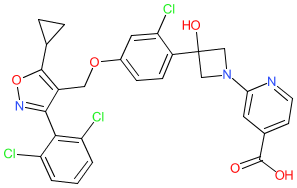|
Synonyms: example 13/9 [US10485795B2] | GS-9674 | GS9674
Compound class:
Synthetic organic
Comment: Cilofexor (GS-9674) is a nonsteroidal farnesoid X receptor (FXR) agonist. It was originally identified by Phenex Pharmaceuticals [1] and is being developed by Gilead Pharmaceuticals for hepatic anti-steatotic activity, and potential to treat nonalcoholic fatty liver disease (NAFLD) and/or nonalcoholic steatohepatitis (NASH). Successful treatment of these liver conditions will most likely be achieved using combinations of antilipemic, anti-inflammatory and anti-fibrotic agents.
Ligand Activity Visualisation ChartsThese are box plot that provide a unique visualisation, summarising all the activity data for a ligand taken from ChEMBL and GtoPdb across multiple targets and species. Click on a plot to see the median, interquartile range, low and high data points. A value of zero indicates that no data are available. A separate chart is created for each target, and where possible the algorithm tries to merge ChEMBL and GtoPdb targets by matching them on name and UniProt accession, for each available species. However, please note that inconsistency in naming of targets may lead to data for the same target being reported across multiple charts. ✖ |
|
|||||||||||||||||||||||||||||||||||
| Bioactivity Comments |
| Cilofexor was selected for devlopment due to its intestinal bias, so as to reduce potential side-effects (HDL cholesterol lowering and elevation of blood markers of steatosis and inflammation; alanine aminotransferase and aspartate aminotransferase) that were observed for earlier iterations of this compound. |
| Selectivity at nuclear hormone receptors | ||||||||||||||||||||||||||||||||||
| Key to terms and symbols | Click column headers to sort | |||||||||||||||||||||||||||||||||
|
||||||||||||||||||||||||||||||||||







